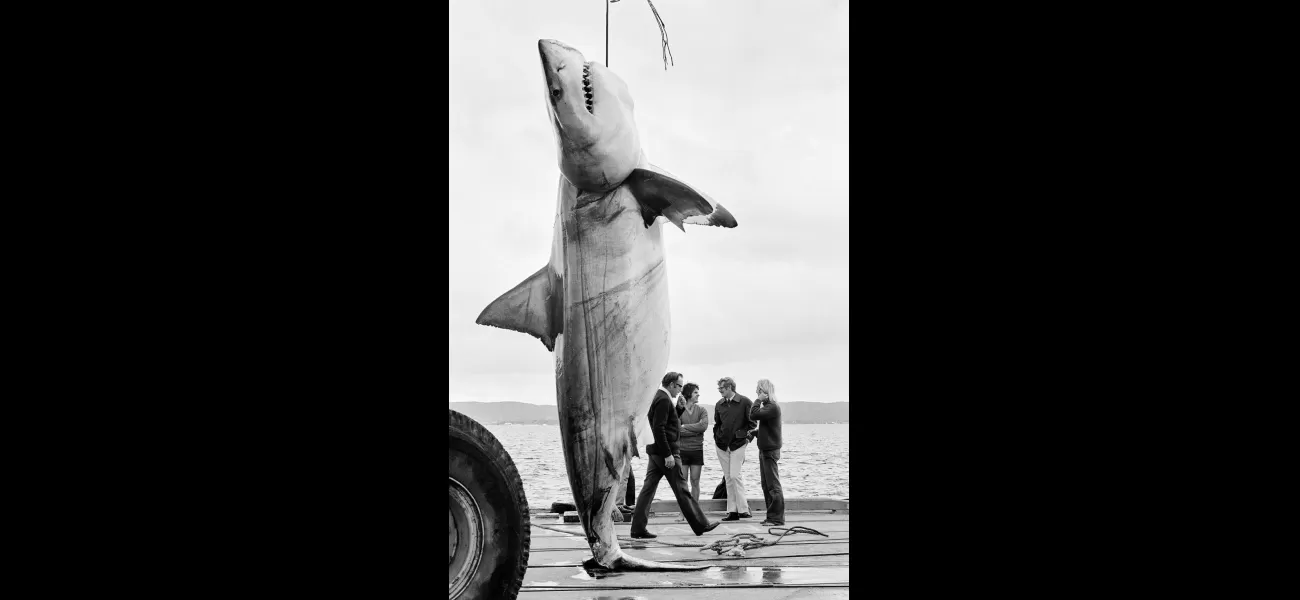The chances of encountering a picture like this again are slim.
In 1975, an Australian fisherman caught a huge great white shark. Today, he would have had to release it due to legal regulations.
August 12th 2024.

Colin Ostle was well aware that he had very little time to capture the massive shark that was lurking in the waters around him. Without wasting a moment, he made the bold decision to lasso the beast instead of using a conventional fishing reel. It was a late afternoon in April of 1975 when Ostle, accompanied by a friend, was out on a tuna fishing boat in the waters off Albany, in Western Australia. As they were going about their business, they suddenly spotted the great white shark, sending shivers down their spines.
This wasn't the first time that Ostle had successfully captured an ocean predator, but this one in particular proved to be a mighty challenge. Its sheer strength was enough to almost overturn the fishermen's boat. Despite the struggle, after a few hours of intense battling, the two fishermen managed to bring their catch to the Albany wharf. And what a catch it was! The great white shark was so enormous that a mobile crane had to be used to lift it onto the shore. It weighed close to 1500 kilograms and measured over five metres in length. It was truly a sight to behold.
As fate would have it, on the day that Ostle caught this monstrous shark, John McKinnon, a photographer for the Australian News and Information Bureau, happened to be in Albany. His photos of the big catch were published in newspapers all across the country and are now preserved in the National Archives' collection. It's quite interesting to note that McKinnon's emotive photo, which captured the true magnitude of the catch, would not have been allowed to be taken in today's times. This is because, since 1999, white sharks have been declared a protected species, meaning that it is illegal to hunt or catch them.
The decision to protect great white sharks was made due to a combination of factors, one of them being the release of Steven Spielberg's blockbuster film, Jaws, just two months after Ostle's impressive catch. The movie, which depicted a massive great white shark terrorizing a holiday island, sparked widespread fear among swimmers and created what is now known as the 'Jaws effect'. This, in turn, led to the portrayal of great whites as dangerous man-eaters. Additionally, concerns about the overfishing of large shark species also played a role in the decision to protect great whites.
However, the belief that great white sharks are man-eaters is a falsehood. Research from the American Museum of Natural History has shown that over 75% of all shark species are either unlikely to encounter a human or are incapable of consuming one. Most shark attacks are a result of poor water visibility or out of curiosity rather than predatory intentions. While it is incredibly rare, shark attacks can occur. However, in Australia, the chances of being attacked by a shark are still significantly lower than being struck by lightning or dying in a car accident.
According to research from the Australian Museum, lightning causes an estimated 5 to 10 deaths and over 100 serious injuries per year, while there were only 11 unprovoked shark attacks recorded in Australia in 2019. So, while it is essential to respect and protect these magnificent creatures, it is also important to understand that they are not the menacing man-eaters that they are often portrayed to be. They are a vital part of our ocean's ecosystem, and their protection is crucial for maintaining a healthy balance in our seas.
This wasn't the first time that Ostle had successfully captured an ocean predator, but this one in particular proved to be a mighty challenge. Its sheer strength was enough to almost overturn the fishermen's boat. Despite the struggle, after a few hours of intense battling, the two fishermen managed to bring their catch to the Albany wharf. And what a catch it was! The great white shark was so enormous that a mobile crane had to be used to lift it onto the shore. It weighed close to 1500 kilograms and measured over five metres in length. It was truly a sight to behold.
As fate would have it, on the day that Ostle caught this monstrous shark, John McKinnon, a photographer for the Australian News and Information Bureau, happened to be in Albany. His photos of the big catch were published in newspapers all across the country and are now preserved in the National Archives' collection. It's quite interesting to note that McKinnon's emotive photo, which captured the true magnitude of the catch, would not have been allowed to be taken in today's times. This is because, since 1999, white sharks have been declared a protected species, meaning that it is illegal to hunt or catch them.
The decision to protect great white sharks was made due to a combination of factors, one of them being the release of Steven Spielberg's blockbuster film, Jaws, just two months after Ostle's impressive catch. The movie, which depicted a massive great white shark terrorizing a holiday island, sparked widespread fear among swimmers and created what is now known as the 'Jaws effect'. This, in turn, led to the portrayal of great whites as dangerous man-eaters. Additionally, concerns about the overfishing of large shark species also played a role in the decision to protect great whites.
However, the belief that great white sharks are man-eaters is a falsehood. Research from the American Museum of Natural History has shown that over 75% of all shark species are either unlikely to encounter a human or are incapable of consuming one. Most shark attacks are a result of poor water visibility or out of curiosity rather than predatory intentions. While it is incredibly rare, shark attacks can occur. However, in Australia, the chances of being attacked by a shark are still significantly lower than being struck by lightning or dying in a car accident.
According to research from the Australian Museum, lightning causes an estimated 5 to 10 deaths and over 100 serious injuries per year, while there were only 11 unprovoked shark attacks recorded in Australia in 2019. So, while it is essential to respect and protect these magnificent creatures, it is also important to understand that they are not the menacing man-eaters that they are often portrayed to be. They are a vital part of our ocean's ecosystem, and their protection is crucial for maintaining a healthy balance in our seas.
[This article has been trending online recently and has been generated with AI. Your feed is customized.]
[Generative AI is experimental.]
0
0
Submit Comment





